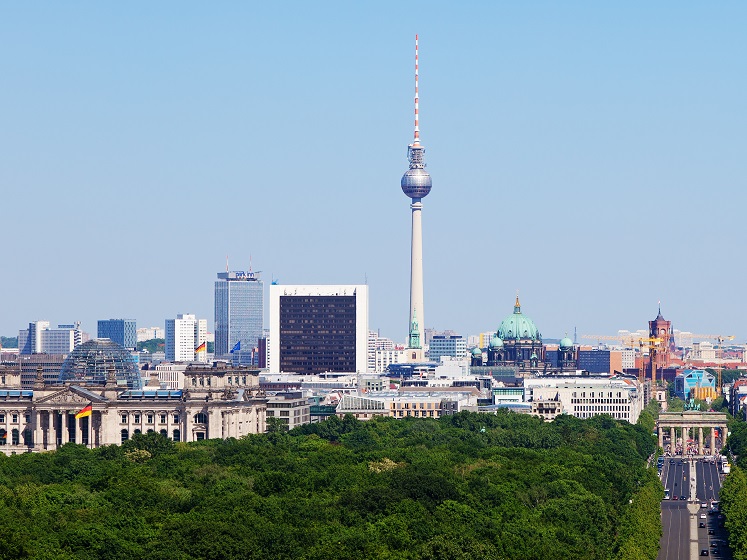 https://richmedia.lse.ac.uk/pressandcomms/201080607_LseThinks_Gabriel_4.mp4
Berlin cityscape Thomas Wolf, CC BY-SA 3.0
https://richmedia.lse.ac.uk/pressandcomms/201080607_LseThinks_Gabriel_4.mp4
Berlin cityscape Thomas Wolf, CC BY-SA 3.0
What makes cities thrive? Is it proximity to natural resources like rivers, oceans or energy reserves? Or does the cumulative effect of population increases stimulate waves of economic activity such as restaurants, bars and shops? Read about a growth identifiying model which has been awarded the prestigious Frisch Medal 2018.
Because of the complex history of many cities, identifying the source of their development is notoriously difficult. But a group of urban economists have developed a model that shows the positive relationship between economic activity and urban density, and predicts how further development will change a city and its surrounding areas.
The scale of the achievement by Gabriel Ahlfeldt, Stephen Redding, Daniel Sturm, and Nikolaus Wolf, who began the project almost a decade ago at LSE, have received the Frisch Medal, has been recognised with one the most prestigious prizes in economics.
Dr Ahlfeldt, of LSE's Department of Geography and Environment, says the challenge was finding the right experiment to identify the driver of urban development. He says: “The idea that density and productivity in cities is linked has been circulating for a long time. But the hard part is to establish where a city’s growth is coming from.”
The researchers sought a case study where a part of a city is reconnected to the economic and social resources of another part to see how it changed the city. They settled on a unique event from history; when East and West Germany reunified in 1991 after 41 years apart. Berlin, Germany’s capital, was at the crux of the divide, hosting two opposing political and economic systems; capitalism in the West and socialism in the East.
Nikolaus Wolf says: “Berlin’s division and unification is a unique testing ground to identify the sources of urban development. When Berlin was split after 1945, the Western part lost access to the heart of the city, the Central Business District. When the Berlin Wall came down in 1989, the City was reunified."
The researchers tracked the fortunes of West Berlin, which remained a market economy during the division period, collecting data on employment, population and rents between the 1930s to the 2000s. They found that property prices and economic activity in the east side of West Berlin, close to the historic central business district in East Berlin, began to fall when the city was divided. Then, during the 1990s, the same area began to grow and develop again.
Dr Ahlfeldt says: “After reunification, West Berlin suddenly had access to all the knowledge and public resources in the resurgent central business district it had been denied. That spurred development in these areas, and land prices close to the central business district increased. This showed that exposure to density has a positive effect on the areas around it.”
Using the evidence from their Berlin study, the researchers established that cities benefit from ‘cumulative causation’. According to the theory, density makes cities more productive, which attracts companies and employees, increasing productivity further. Urban density also increases demand for services, which increases consumption, with services such as theatres, restaurants, cafés and shops all emerging as their consumer base grows.
Professor Redding, formerly of LSE and currently Professor of Economics at Princeton University, explains: “We show that our model is successful in explaining the observed reorganisation of economic activity within West Berlin, not only qualitatively, but also quantitatively.”
The research team believe the model will have practical applications for urban planners making decisions on infrastructure and housing. Professor Sturm of the Department of Economics says: “If a city is considering a subway, our model will show how property prices are likely to increase. We will also be able to simulate what happens to the places close to the new infrastructure, and the economic spillover into other locations.”
“The model can also show when improving one area is likely to hurt another area, when people and firms will move away to the better connected and more desirable locations,” Professor Sturm adds.
Recognition in the form of the Frisch medal is viewed by Dr Ahlfeldt as a major breakthrough for the burgeoning field of urban economics. He says: “The field has been growing, we have better data, lots of talented young scholars studying what makes cities tick.”
“I think our work is important as more and more people are moving to live in cities all over the world. Understanding what attracts people to cities, and what puts barriers to urban growth, are vital questions.”
“And as this project was born at LSE, the prize puts the School at the centre of the field of urban economics, an exciting place to be.”